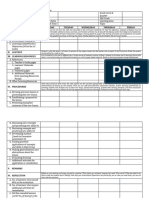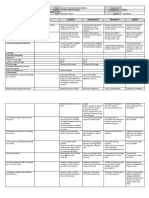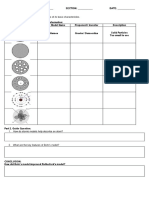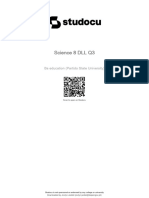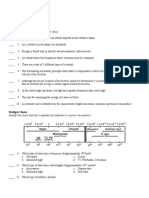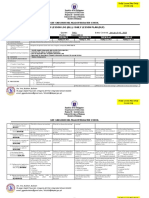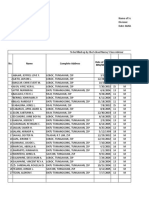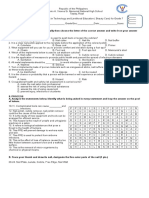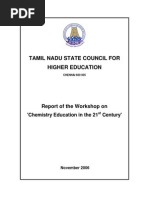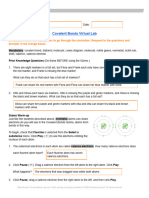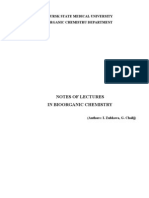0 ratings0% found this document useful (0 votes)
112 viewsSecond Quarter
Second Quarter
Uploaded by
Shellane Blanco SarduaThis document outlines the content, learning competencies, and objectives covered in the second grading period for a science class, including four modules on electronic structure of matter, chemical bonding, carbon compounds, and the mole concept. The modules aim to improve students' understanding of atomic structure, ionic and covalent bonding, organic chemistry, and applying the mole concept to stoichiometry. A variety of activities like pre-assessments, experiments, and summative tests are included to help students meet the learning competencies for each topic.
Copyright:
© All Rights Reserved
Available Formats
Download as DOCX, PDF, TXT or read online from Scribd
Second Quarter
Second Quarter
Uploaded by
Shellane Blanco Sardua0 ratings0% found this document useful (0 votes)
112 views4 pagesThis document outlines the content, learning competencies, and objectives covered in the second grading period for a science class, including four modules on electronic structure of matter, chemical bonding, carbon compounds, and the mole concept. The modules aim to improve students' understanding of atomic structure, ionic and covalent bonding, organic chemistry, and applying the mole concept to stoichiometry. A variety of activities like pre-assessments, experiments, and summative tests are included to help students meet the learning competencies for each topic.
Original Title
second Quarter.docx
Copyright
© © All Rights Reserved
Available Formats
DOCX, PDF, TXT or read online from Scribd
Share this document
Did you find this document useful?
Is this content inappropriate?
This document outlines the content, learning competencies, and objectives covered in the second grading period for a science class, including four modules on electronic structure of matter, chemical bonding, carbon compounds, and the mole concept. The modules aim to improve students' understanding of atomic structure, ionic and covalent bonding, organic chemistry, and applying the mole concept to stoichiometry. A variety of activities like pre-assessments, experiments, and summative tests are included to help students meet the learning competencies for each topic.
Copyright:
© All Rights Reserved
Available Formats
Download as DOCX, PDF, TXT or read online from Scribd
Download as docx, pdf, or txt
0 ratings0% found this document useful (0 votes)
112 views4 pagesSecond Quarter
Second Quarter
Uploaded by
Shellane Blanco SarduaThis document outlines the content, learning competencies, and objectives covered in the second grading period for a science class, including four modules on electronic structure of matter, chemical bonding, carbon compounds, and the mole concept. The modules aim to improve students' understanding of atomic structure, ionic and covalent bonding, organic chemistry, and applying the mole concept to stoichiometry. A variety of activities like pre-assessments, experiments, and summative tests are included to help students meet the learning competencies for each topic.
Copyright:
© All Rights Reserved
Available Formats
Download as DOCX, PDF, TXT or read online from Scribd
Download as docx, pdf, or txt
You are on page 1of 4
Quarter: SECOND GRADING PERIOD
Content: UNIT 1: COUNTLESS AND ACTIVE PARTICLES OF MATTER
CONTENT LEARNING COMPETENCY CODE OBJECTIVES/ACTIVITIES
Module 1: Electronic 1. describe how the Bohr model of the S9MT-IIa-13a Pre-assessment/Checking
Structure of Matter atom improved Rutherford’s atomic Determine the characteristics colors that
CS: The learners demonstrate model. metals salts emit and relate the color
an understanding of the emitted by metal salt to the structure of
development of atomic atom
models that led to the 2. explain how the Quantum S9MT-IIa-13b Describe how it is likely to find the
description of the behavior of Mechanical model of the atom electron in an atom by probability
electrons within atoms describes the energies and positions of Define atomic orbital and describe the
the electrons. quantum mechanical model of the atom
Write the electron configuration of the
elements in the third period
Summative Test (Module 1)
Holiday (Ninoy Aquino Day)
Holiday (Muslim Holiday)
Module 2: Chemical 3. explain the formation of ionic and S8MT-IIA-13C Pre-assessment
Bonding covalent bonds Identify the number of valence electrons
CS: how the atoms combine of atoms
with the other atoms by HOLIDAY
transferring or by sharing Compare the electronegativity and
electrons and forces that ionization energy values of metals and
hold metals together non-metals
Write the Lewis symbol of the common
metals and non-metals
Show the relationship among the number
of valence electrons, electronegativity
and ionization energy
Remediation class/Enrichment activity
4. recognize different types of S9MT-IIb-14 Illustrate how an ionic bond is formed
compounds (ionic or covalent) based and cite examples
on their properties such as melting Differentiate between polar and nonpolar
point, hardness, polarity, and electrical covalent bonds and cite examples
and thermal conductivity Give examples of compounds having
5. explain how ions are formed S9MT-IIe-f-16 ionic bonds and how the bond is formed
6. explain properties of metals in terms S9MT-IIc-d-15 Make/construct a model of a metallic
of their structure bond
Remediation/Enrichment activity
Summative test (Module 2)
Module 3: The Carbon 7. explain the structure of the carbon S9MT-IIg-17 Pre-assessment/Checking
Compounds atoms affects the types of bonds it Recognize the uses of common organic
CS: the type of bonds that forms compounds
carbon forms that result in Observe the properties of common
the diversity of carbon organic compounds and relate it to their
compounds uses
Remediation/Enrichment Activity
Recognize common kinds of alkanes,
alkenes and alkynes and their uses
Identify the types of bonds formed in
alkanes, alkenes and alkynes
Relate the structures of alkanes, alkenes
and alkynes to their properties
Investigate how a common organic
compound namely ethyne can ripen
fruits faster
Recognize the uses of common alcohols
Identify similarities of different kinds of
alcohols
Relate these similarities to the common
properties they have
Give the common uses of acetone and
formalin
Relate the structure of acetone and
formalin to the carbonyl compounds
where they belong
Remediation/Enrichment activity
Summative test (Module 3)
Module 4: What’s in a 9. use the mole concept to express S9MT-IIi-19 Pre-Assessment
Mole? mass of substances, and; Measure the mass of a given number of
CS: the unit, mole that objects
quantitatively measures Record the mass showing the precision
that number of very small of the measuring device
particles of matter. 10. determine the percentage S9MT-IIj-20 Convert the number of items to its
PS: analyze the percentage composition of a compound given its equivalent mass in grams or vice versa
composition of different empirical formula and vice versa Remediation/Enrichment activity
brands of two food products Compute for the molar mass of common
and decide on the product’s substances
appropriate percentage Describe the relationships among
composition number of moles and mass number
Describe the relationship between
number of moles and number of particles
Remediation/Enrichment activity
World Teacher’s Day
Define percentage composition of a
given compound
Solve problems involving percentage
composition of a given compound
Apply the concept of %age composition
in choosing grocery item
Construct a concept map about Mole
concept
Remediation/Enrichment activity
Summative test (Module 4)
Review class for the 2nd Periodic Exam
Review class for the 2nd Periodic Exam
Second Periodic Exam
You might also like
- Principles of General Chemistry 3rd Edition Martin Silberberg 2024 Scribd DownloadDocument40 pagesPrinciples of General Chemistry 3rd Edition Martin Silberberg 2024 Scribd Downloadleharbobetyl100% (3)
- Test Bank With Solution Manual For Biology, 6th Edition by Robert Brooker, Eric WidmaierDocument41 pagesTest Bank With Solution Manual For Biology, 6th Edition by Robert Brooker, Eric WidmaierMarcus King100% (1)
- Chemical Bonding-AnswersDocument2 pagesChemical Bonding-AnswersJaznMon80% (10)
- Candycompounds PDFDocument6 pagesCandycompounds PDFHendrix Antonni AmanteNo ratings yet
- 2nd QTR MOD. 1 DLLDocument191 pages2nd QTR MOD. 1 DLLleiziah xyrille maturanNo ratings yet
- Supplemental Activities in Science 9 Quarter 2, Week 6Document2 pagesSupplemental Activities in Science 9 Quarter 2, Week 6Rose Ann ChavezNo ratings yet
- DLL 2nd Week Quarter 2Document5 pagesDLL 2nd Week Quarter 2Anne McSciNo ratings yet
- Lawy National High School: Weekly Learning PlanDocument3 pagesLawy National High School: Weekly Learning PlanMerrie Anne Pascual BagsicNo ratings yet
- COT 2 Organic Compounds PropertiesDocument3 pagesCOT 2 Organic Compounds PropertiesDecylyn Villa - MacafeNo ratings yet
- The Magnetic Property of An Atom and Atoms Atomic OrbitalsDocument12 pagesThe Magnetic Property of An Atom and Atoms Atomic OrbitalsJanne Lorraine Garcia-EleazarNo ratings yet
- DLL - Science 9 - 2nd Quarter - Week 3Document6 pagesDLL - Science 9 - 2nd Quarter - Week 3Rodney BarbaNo ratings yet
- Final Co1Document5 pagesFinal Co1michelle.patauegNo ratings yet
- DLL chemNOV15Document5 pagesDLL chemNOV15Rosallie Caaya-NuezNo ratings yet
- DLP Quantum Model of The AtomsDocument14 pagesDLP Quantum Model of The AtomsDaniah AllemaNo ratings yet
- History of The Modern Periodic TableDocument41 pagesHistory of The Modern Periodic TableannakathirNo ratings yet
- 1 SHS DAILY LESSON LOG DLL TEMPLATE byDocument3 pages1 SHS DAILY LESSON LOG DLL TEMPLATE byRodel EspañolaNo ratings yet
- 2nd QRTR DLL-Grade - 9Document7 pages2nd QRTR DLL-Grade - 9CatherineNo ratings yet
- Science 9 ODL IDEA L2 PRINTEDDocument3 pagesScience 9 ODL IDEA L2 PRINTEDClarice Jenn Malto100% (1)
- Comets Venn DiagramDocument1 pageComets Venn DiagramAndrewdKiatKiatNo ratings yet
- Tatay DLL Grade 8Document6 pagesTatay DLL Grade 8Charmaine MontialbucioNo ratings yet
- Lesson Plan Volcano Grade 9 ScienceDocument5 pagesLesson Plan Volcano Grade 9 ScienceJerwin ForteoNo ratings yet
- DLL Sci 9 Q2 W2Document8 pagesDLL Sci 9 Q2 W2Carmina DuldulaoNo ratings yet
- Grade9 Unit 4 Heat Work and EnergyDocument25 pagesGrade9 Unit 4 Heat Work and EnergyRiaNo ratings yet
- Cmap Science 9Document3 pagesCmap Science 9Zharina Ann EstavilloNo ratings yet
- Quiz Grade 8 Phase Changes of MatterDocument8 pagesQuiz Grade 8 Phase Changes of MatterChelleNo ratings yet
- 19Document35 pages19Ailyn Ricor TawakalNo ratings yet
- Holy Triniy Acadamy of Calamba, Inc.: Shepherding The Heart, Training The MindDocument3 pagesHoly Triniy Acadamy of Calamba, Inc.: Shepherding The Heart, Training The MindChristine Ainah Pahilagao SalesNo ratings yet
- 2nd Quarter Activity SheetDocument17 pages2nd Quarter Activity SheetMarilyn OngkikoNo ratings yet
- Isomerism in Alkanes, Cycloalkanes, and Alkenes Using Molecular ModelsDocument4 pagesIsomerism in Alkanes, Cycloalkanes, and Alkenes Using Molecular Modelsalbertvdatu278No ratings yet
- SCIENCE 9-SY 2022-2023-Q2-W8-January 9-13,2023Document4 pagesSCIENCE 9-SY 2022-2023-Q2-W8-January 9-13,2023NOVA LESLIE AGAPAYNo ratings yet
- RAISEPlus GRADE 9 Impulse and MomentumDocument2 pagesRAISEPlus GRADE 9 Impulse and Momentumpj oroscoNo ratings yet
- Science 8Document17 pagesScience 8ellowcodyNo ratings yet
- Science 9 CMDocument7 pagesScience 9 CMIvy Mae ArnaizNo ratings yet
- Grade-9-Science Q2 Wk2 GLAKDocument24 pagesGrade-9-Science Q2 Wk2 GLAKMorana TuNo ratings yet
- SCIENCE 9 Subject Overview 2023 2024Document5 pagesSCIENCE 9 Subject Overview 2023 2024Paulo MoralesNo ratings yet
- 3rd Round DLLDocument5 pages3rd Round DLLClaudette Espiritu Santo AralarNo ratings yet
- Semi DLP Tom 10Document2 pagesSemi DLP Tom 10ellis garciaNo ratings yet
- S9MT-IIa13 Covalent Bondlp2nd QuarterDocument4 pagesS9MT-IIa13 Covalent Bondlp2nd QuarterJoy ValdezNo ratings yet
- COT DLP RelativityDocument10 pagesCOT DLP Relativitykarinajean.padriganoNo ratings yet
- DLL FormatDocument4 pagesDLL FormatElena LaguyoNo ratings yet
- Science 8 DLL (Reference)Document40 pagesScience 8 DLL (Reference)Jovilyn JardielNo ratings yet
- Lesson Plan For Grade 9 Science Quarter 1 Week 6Document3 pagesLesson Plan For Grade 9 Science Quarter 1 Week 6Windie M. BemidaNo ratings yet
- DLL (Motion in 2 Dimension)Document3 pagesDLL (Motion in 2 Dimension)JeanRachoPaynandosNo ratings yet
- Old Quiz Electron ConfigurationDocument6 pagesOld Quiz Electron ConfigurationtinaNo ratings yet
- Electron DLLDocument4 pagesElectron DLLBimbs LazoNo ratings yet
- DLL For Grade 9 Science Q3Document5 pagesDLL For Grade 9 Science Q3Joahna Reena QuejadoNo ratings yet
- CG Research Ran2022Document21 pagesCG Research Ran2022Ramon Lord A. NerierNo ratings yet
- Week 2 - LeDocument10 pagesWeek 2 - LeRodney BarbaNo ratings yet
- QTR 2 Module 3 Other Living Things Besides Plants and AnimalDocument9 pagesQTR 2 Module 3 Other Living Things Besides Plants and AnimalNick Bantolo67% (3)
- Science 7 Q4 SLM11Document15 pagesScience 7 Q4 SLM11Seen Tuna-doughNo ratings yet
- History and Models of The Atom: Click On MeDocument26 pagesHistory and Models of The Atom: Click On MeRon Adrian Sarte SebastianNo ratings yet
- CG ResearchDocument16 pagesCG ResearchArman VillagraciaNo ratings yet
- Scie DLL q2 m6 CARBON COMPOUNDSDocument3 pagesScie DLL q2 m6 CARBON COMPOUNDSRoxanne Alcaide OrdoñezNo ratings yet
- DLP Q2 Week 7 D3Document5 pagesDLP Q2 Week 7 D3Menchie YabaNo ratings yet
- Performance Tasks in Science 9 M1&2Document3 pagesPerformance Tasks in Science 9 M1&2Joel C. JavierNo ratings yet
- DLL - Science 9 - Q2Document37 pagesDLL - Science 9 - Q2Nazer M. LacaboNo ratings yet
- Activity Sheet 2Document3 pagesActivity Sheet 2Anjhiene Camba100% (1)
- Grade 9 DLL ScienceDocument32 pagesGrade 9 DLL ScienceKristine Joy PanaguitonNo ratings yet
- Melcs Advanced PhysicsDocument8 pagesMelcs Advanced PhysicsJairos Marata BrasileñoNo ratings yet
- Science 8 Second Quarter Module (PIVOT) Grade 8 ModulesDocument1 pageScience 8 Second Quarter Module (PIVOT) Grade 8 ModulesCrissy PeachNo ratings yet
- Corazon C Aquino High SchoolDocument6 pagesCorazon C Aquino High SchoolBernadette Macadangdang100% (2)
- MULTIPLE CHOICE. Choose The One Alternative That Best Completes The Statement or Answers The QuestionDocument4 pagesMULTIPLE CHOICE. Choose The One Alternative That Best Completes The Statement or Answers The QuestionElsie VanpraetNo ratings yet
- Science 9 Q3 LAS 2Document4 pagesScience 9 Q3 LAS 2Joselyn Villena MarquezNo ratings yet
- Teknik JWB Kertas 3Document13 pagesTeknik JWB Kertas 3THANABALAN A/L MUNUSWAMY MoeNo ratings yet
- My COTDocument3 pagesMy COTShellane Blanco SarduaNo ratings yet
- SBI MasterListDocument15 pagesSBI MasterListShellane Blanco SarduaNo ratings yet
- 4th Periodical TestDocument3 pages4th Periodical TestShellane Blanco SarduaNo ratings yet
- Southern Mindanao Colleges Reporter: Shellane S. Mably Subject: Educ 234 Maed Summer Class 2017Document4 pagesSouthern Mindanao Colleges Reporter: Shellane S. Mably Subject: Educ 234 Maed Summer Class 2017Shellane Blanco SarduaNo ratings yet
- First GradingDocument4 pagesFirst GradingShellane Blanco Sardua100% (1)
- First GradingDocument4 pagesFirst GradingShellane Blanco Sardua100% (1)
- Shane KraDocument62 pagesShane KraShellane Blanco SarduaNo ratings yet
- Química de MaterialesDocument144 pagesQuímica de MaterialesFransesco CalabreseNo ratings yet
- The Chemistry of Engineering MaterialsDocument62 pagesThe Chemistry of Engineering MaterialsHidden NameNo ratings yet
- Boardworks IBO Chemistry Diploma A-Level Mapping GridDocument28 pagesBoardworks IBO Chemistry Diploma A-Level Mapping GridMary MannuNo ratings yet
- Chemical Bonding and Molecular Structure - Lecture NotesDocument51 pagesChemical Bonding and Molecular Structure - Lecture NotesEdith EatonNo ratings yet
- q1l3 - 2nd Sem Physical ScienceDocument12 pagesq1l3 - 2nd Sem Physical ScienceBilly Jasper DomingoNo ratings yet
- Chemistry Form 6 Chap 03 NewDocument92 pagesChemistry Form 6 Chap 03 Newbrandam0% (1)
- 5070 w02 QP 1Document16 pages5070 w02 QP 1Hendrawan SaputraNo ratings yet
- QB 10 Chapter 1&2Document5 pagesQB 10 Chapter 1&2Nitin SNo ratings yet
- Carbon and Its CompoundsDocument39 pagesCarbon and Its Compoundsrabi1973No ratings yet
- A Textbook PDFDocument140 pagesA Textbook PDFIvana05No ratings yet
- Ahmed Zewail: The King of FemtolandDocument8 pagesAhmed Zewail: The King of FemtolandMaram SyegNo ratings yet
- Periodic Properties Hazari SirDocument9 pagesPeriodic Properties Hazari Sirriaz.atom4No ratings yet
- Physical Science U4Document74 pagesPhysical Science U4Knight PlayzNo ratings yet
- Chemistry 9 Chap 1 Long QADocument17 pagesChemistry 9 Chap 1 Long QAAkbar Ali AhmedNo ratings yet
- COMPARATIVE STUDY FOR P - BLOCK ELEMENTSDocument10 pagesCOMPARATIVE STUDY FOR P - BLOCK ELEMENTSvishuNo ratings yet
- IMF Exam PracticeDocument3 pagesIMF Exam PracticeJacob StephansNo ratings yet
- Chemistry Education in The 21st CenturyDocument106 pagesChemistry Education in The 21st CenturyAbhishek BansalNo ratings yet
- Our Fragile Planet - Hydrosphere - Freshwater Sytems and PollutionDocument209 pagesOur Fragile Planet - Hydrosphere - Freshwater Sytems and Pollutionlelo2k3100% (2)
- PHSC Week 1 9-1Document66 pagesPHSC Week 1 9-1Jillian Anika CuerdoNo ratings yet
- Ionic and Covalent BondingDocument2 pagesIonic and Covalent Bondingiamaprogamer999No ratings yet
- Covalent Compounds Quiz 1Document3 pagesCovalent Compounds Quiz 1Rania AbdellatifNo ratings yet
- Covalent Bonds Virtual LabDocument8 pagesCovalent Bonds Virtual LabVibes chyNo ratings yet
- Hsslive Xi Chemistry Most Important Questions Answers Anil 2024 UpdatedDocument43 pagesHsslive Xi Chemistry Most Important Questions Answers Anil 2024 Updatedddreamboy289No ratings yet
- Index: Sample Test Paper (STP)Document70 pagesIndex: Sample Test Paper (STP)Harshvardhan S. KantimahanthiNo ratings yet
- CHEMICAL BONDING. Revision WorksheetDocument3 pagesCHEMICAL BONDING. Revision WorksheetLalithNo ratings yet
- Bio-Organic Chem LecturesDocument205 pagesBio-Organic Chem LecturesРаони Мессиас100% (2)















